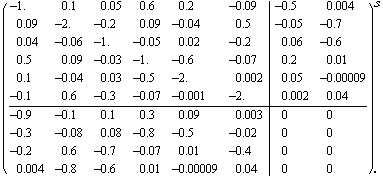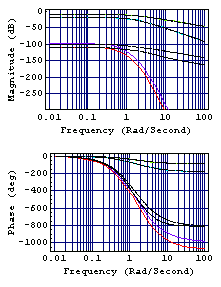|
7.2 Model Reduction Using Schur and Square-Root Methods
Given an  order continuous-time state-space system order continuous-time state-space system


the model reduction problem is one of finding a state-space system of order  , such that the error with respect to the , such that the error with respect to the  norm norm

is minimized over all state-space systems of order  ; where ; where  is the transfer function of the original model and is the transfer function of the original model and  is the transfer function of the reduced-order model. The exact minimization of is the transfer function of the reduced-order model. The exact minimization of  is a complicated task and, in practice, one has to be satisfied with a less strict requirement, such as the guaranteed upper bound on is a complicated task and, in practice, one has to be satisfied with a less strict requirement, such as the guaranteed upper bound on 

where  are the Hankel singular values. The dominant Hankel singular values are used to determine are the Hankel singular values. The dominant Hankel singular values are used to determine  . .
Advanced Numerical Methods provides two new numerical methods, namely the Schur method and the square-root method. Both are accessible using the function DominantSubsystem, introduced in Section 8.5 of Control System Professional. The Schur method, invoked with ReductionMethod  SchurDecomposition, is based on the reduction of the product of SchurDecomposition, is based on the reduction of the product of  to the ordered real Schur form. The reduced-order model is then formed by finding the orthonormal bases for the right and left invariant subspaces corresponding to the dominant eigenvalues of the matrix to the ordered real Schur form. The reduced-order model is then formed by finding the orthonormal bases for the right and left invariant subspaces corresponding to the dominant eigenvalues of the matrix  using orthogonal transformations. using orthogonal transformations.
This procedure does not give an internally balanced realization; however, the  order transfer function order transfer function  , obtained by the method, has the same properties as the transfer function of the internal balancing procedure. Specifically, the matrix , obtained by the method, has the same properties as the transfer function of the internal balancing procedure. Specifically, the matrix  of the reduced-order model is stable and the transfer function of the reduced-order model is stable and the transfer function  satisfies the error bound Eq. (7.9). satisfies the error bound Eq. (7.9).
The square-root method is invoked with ReductionMethod  SquareRoot. The method results from incorporating the Hammarling algorithm to compute the Cholesky factor of a Gramian into the Schur method. The square-root method gives a partial internal balancing in the sense that the only retained strong states are balanced. SquareRoot. The method results from incorporating the Hammarling algorithm to compute the Cholesky factor of a Gramian into the Schur method. The square-root method gives a partial internal balancing in the sense that the only retained strong states are balanced.
Although both the Schur method and the square-root method provide reasonable fits in the frequency domain (at least for lower frequencies), the time responses of the reduced-order models are not always as good fits to those of the original higher-order systems. However, both these methods provide stable reduced-order models in the case when the original model is stable. The details of these methods can be found in Safonov and Chiang (1989) and Datta (2003).




Model reduction methods.
Make sure the application is loaded.
In[1]:=
Load the collection of test examples.
In[2]:=
This experiment uses the state-space model of an absorption column.
In[3]:=
Here are the numbers of states, inputs, and outputs of the system.
In[4]:=
Out[4]=
Here are the ratios of each Hankel singular value to the largest one. The Hankel singular values are computed using the Cholesky factors of the controllability and observability Gramians.
In[5]:=
In[6]:=
Out[6]=
Selecting the threshold  in the ratios retains only the first six strongest modes. This is the corresponding reduced-order model obtained by the Schur method. in the ratios retains only the first six strongest modes. This is the corresponding reduced-order model obtained by the Schur method.
In[7]:=
Out[7]//NumberForm=
The reduced-order model obtained by the Schur method is not internally balanced. The controllability Gramian is not diagonal.
In[8]:=
Out[8]//NumberForm=
Here is the reduced-order model of the absorption column system obtained by the square-root method.
In[9]:=
Out[9]//NumberForm=
The reduced-order model obtained by the square-root method is internally balanced.
In[10]:=
Out[10]=
In[11]:=
Out[11]=
The frequency response from the first input of the original system (solid lines) is compared with that of each of the reduced-order models obtained by the Schur method (dotted lines) and the square-root method (thick dotted lines). The graphs show that the transfer functions of the reduced-order models in both cases match closely at the low frequencies, while they differ considerably at the higher frequencies.
In[12]:=

|